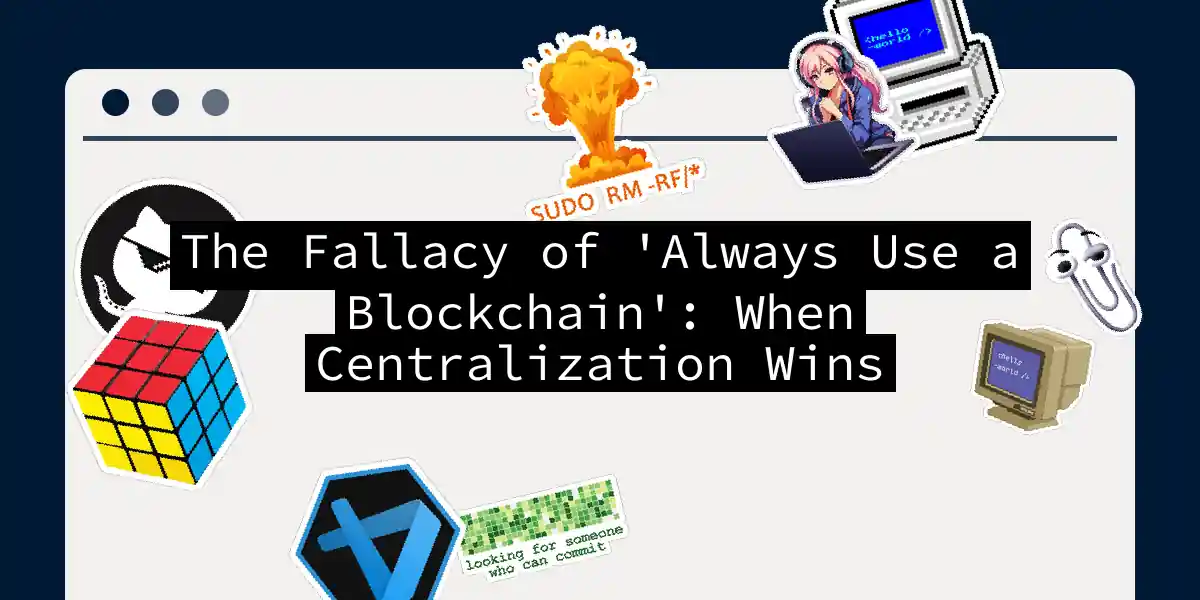Let me tell you a secret: sometimes blockchain is like using a sledgehammer to crack a nut… while wearing a tinfoil hat. Today we’ll explore why chasing decentralization at all costs might leave you holding a very expensive bag of magic beans.
When the Emperor Has No Hash
Blockchain evangelists will have you believe every system needs a distributed ledger. Meanwhile, AWS has entered the chat:
# Centralized user authentication (The horror!)
import sqlite3
def validate_user(user_id):
conn = sqlite3.connect('users.db')
cursor = conn.cursor()
cursor.execute('SELECT verified FROM users WHERE id = ?', (user_id,))
return cursor.fetchone() == 1
This simple snippet handles authentication faster and cheaper than any smart contract. But wait - where’s the 51-node consensus? The gas fees? The existential dread of quantum computing?
The Three Horsemen of Blockchain Overkill:
- The “Trustless” Trap (When you actually trust your partners)
- Throughput Theater (Where TPS stands for “Transactions Per Season”)
- Immutability Incontinence (When you really need to fix that bug)
Case Studies: Blockchain’s Stainless Steel Kitchen
Let’s examine real-world scenarios where blockchain added more value than a screen door on a submarine: 1. The $500 Million Sandwich Attack A major DeFi protocol insisted on full decentralization… until a hacker exploited their AMM. The “fix”? A centralized court order to reverse transactions. Oops. 2. Ethereum’s Validator Cartel 32 ETH to stake sounds democratic… until you realize Lido controls 32% of staked ETH. It’s like claiming you’re decentralized because you have 10,000 nodes… all running in Mark Zuckerberg’s basement.
// Classic decentralized vulnerability
contract VulnurableDAO {
mapping(address => uint) public balances;
function withdraw() public {
require(balances[msg.sender] > 0);
(bool success, ) = msg.sender.call{value: balances[msg.sender]}("");
require(success);
balances[msg.sender] = 0;
}
}
This reentrancy magnet is why some projects are rediscovering the joys of… gasp… centralized transaction validation.
The Decision Matrix: Choosing Your Poison
When designing systems, ask these uncomfortable questions:
- Cost of Failure: If your coffee shop loyalty program fails, does it matter? If your nuclear launch codes leak… maybe?
- Update Frequency: Changing consensus rules vs.
ALTER TABLE - Throughput Needs: VISA handles 65k TPS. Ethereum does… 15.
When Centralization Strikes Back
Let’s explore scenarios where old-school centralization wins:
1. Enterprise Supply Chains
Walmart’s food tracking system uses… wait for it… Hyperledger Fabric with permissioned nodes. Because sometimes you just need to know which farm grew your lettuce, not preserve that information for the heat death of the universe.
2. Small-Scale dApps
That NFT project for local artists? The “decentralized” frontend is hosted on… Google Cloud. The IPFS files? Pinned through… Infura. The decentralization? Mostly theoretical.
3. Rapid Prototyping
Building your MVP on blockchain is like test-driving a rocket ship to buy groceries. Sometimes PostgreSQL is just fine:
# Centralized transaction ledger
def log_transaction(sender, receiver, amount):
with open('transactions.csv', 'a') as f:
f.write(f"{datetime.now()},{sender},{receiver},{amount}\n")
The Hybrid Horizon
Smart architects mix approaches like a mad scientist:
- Centralized processing with blockchain receipts
- Federated validation pools
- Blockchain-backed identity with traditional auth Remember: the most secure system in existence is the one that’s never been connected to the internet. The second most secure? Probably not your Solidity contract.
Conclusion: Decentralization’s Uncanny Valley
Blockchain is brilliant… when you actually need what it provides. For other cases? Let’s stop pretending distributed ledgers are the answer to life, the universe, and your to-do list app. Next time someone shouts “decentralize all the things!”, ask them: Would you store your birth certificate in a public blockchain? How about your search history? Exactly. Now pass me that good old PostgreSQL connection string - we’ve got work to do.
